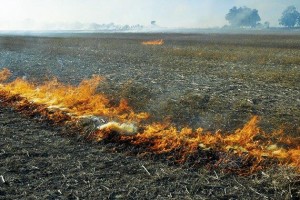Contributed by Science & Technology Division, Taipei Economic and Culture Center (TECC), India
 The bustling city of Del hi has been greatly affected by pollution in recent times with pollutants in the air, water and soil disrupting normal life and health. While political and social scientists along with experts deliberate on ways and means to tackle this grave issue, scientists from Taiwan have offered a prescription using agricultural waste and bamboo to fight this lethal challenge – not just for existing cities but upcoming smart cities that will soon dot India all across.
The bustling city of Del hi has been greatly affected by pollution in recent times with pollutants in the air, water and soil disrupting normal life and health. While political and social scientists along with experts deliberate on ways and means to tackle this grave issue, scientists from Taiwan have offered a prescription using agricultural waste and bamboo to fight this lethal challenge – not just for existing cities but upcoming smart cities that will soon dot India all across.
Taiwanese ambassador, Chung Kwang Tien who functions as Representative, TECC, has always been sensitive to issues that would benefit Indian and Taiwanese people and has been work-ing single mindedly towards this purpose. Elaborating on a recently received article from TECC, Prof. Dr. Henry H. Chen, Counsellor & Director, Science & Technology Division (TECC) elaborated on this paper and how it can truly be a “win-win” situation if Taiwan and India collaborate.
Air Pollution
 The same old problem, most of the time, people living in Delhi have no choice but to breath and fight with foul air. Those people like taxi drivers, rickshaw-walas, commuters and street vendors, who pour into the city from all quarters every day to earn their living, who are exposed the most on the road due to dense smog are at high risk due to inhalation of poisonous air which crosses many times the permissible levels of pollutants. Such essential components in polluted air may include particulate matter (PM), ozone (O3), nitrous oxide (NOx), sulphur dioxide (SO2), carbon monoxide (CO), volatile organic compounds (VOCs) and other heavy metals.
The same old problem, most of the time, people living in Delhi have no choice but to breath and fight with foul air. Those people like taxi drivers, rickshaw-walas, commuters and street vendors, who pour into the city from all quarters every day to earn their living, who are exposed the most on the road due to dense smog are at high risk due to inhalation of poisonous air which crosses many times the permissible levels of pollutants. Such essential components in polluted air may include particulate matter (PM), ozone (O3), nitrous oxide (NOx), sulphur dioxide (SO2), carbon monoxide (CO), volatile organic compounds (VOCs) and other heavy metals.
Many researches have revealed that long-term exposure and intake of such environmental pollutants may lead to severe health consequences. According to the media report, a study showed a total number of premature deaths, adults over 30 years in Delhi and Mumbai in 2015, resulted from polluted air are almost 81,000 people, and cost is approximate Rs 70,000 crore, which is about 0.71% of the country’s GDP. It also added that the actual figure of deaths might be higher as collected data was mostly on PM10 other than PM 2.5.
 Most of foreigners, especially for those who reside in Delhi-NCR, would open an APP on the smartphone before leaving for work every morning in winter and check updated PM2.5 and PM10 AQI recorded by nearby monitoring station. Such a move is mainly to see if they have to wear an anti-pollution mask while going out. Besides, air purifiers have become necessary for being installed indoors such as in our own houses, offices or working premises. To all residents in Delhi, aspiring for clean air is always everyone’s wish and desire. The photograph was taken at Central Delhi in the afternoon immediately after the Diwali festival.
Most of foreigners, especially for those who reside in Delhi-NCR, would open an APP on the smartphone before leaving for work every morning in winter and check updated PM2.5 and PM10 AQI recorded by nearby monitoring station. Such a move is mainly to see if they have to wear an anti-pollution mask while going out. Besides, air purifiers have become necessary for being installed indoors such as in our own houses, offices or working premises. To all residents in Delhi, aspiring for clean air is always everyone’s wish and desire. The photograph was taken at Central Delhi in the afternoon immediately after the Diwali festival.
Reducing air pollution – a tough task
No doubt, to cut air pollution and clean up the air in urban area has been a tough task in harsh winter weather for Delhi Government. Aiming to curb polluted air and mitigate the suffering of the people during these pollution spikes, some strong measures were already been taken in the short-term. Such urgent actions were mainly of odd-even car numbers rule, trade restriction for some specific diesel vehicles, CNG vehicles promotion in Delhi-NCR and outdoor installation of air purifier machines at some major intersections and most polluted zones in the Capital. To intensify reducing pollution levels, according to the news, Delhi Government and New Delhi Municipal Council are mulling steps like reducing fares of public transport to discourage citizen from using private cars, increasing parking charges, introducing electric vehicles and other logical and necessary steps. Even from a foreigners’ point of view, a continued Swachh Bharat Abhiyan in a way might help to bring down air pollution on the roads. We see all efforts have been made in every aspect in the last year, but it turned out that the number of registered vehicles has still reached a new high record in the end, almost 1-crore (10 million) in 2015-16 fiscal year in the national Capital, the most number of cars in the country. In practical, implementing moves to fight Delhi’s pollution would not be an easy task indeed.
Vehicular and other reasons for air pollution
Published surveys or research reports conducted by academic faculty from the esteemed IITs indicated that apart from increasing number of vehicles some other factors like dust from roadside construction activities, high traffic congestion, emissions from factories or open burning of municipal waste and tyres, etc. are sources as well contributing to poor quality of air in Delhi-NCR.
Burning agricultural waste in farms
Not long ago, it was reported that straw or stubble residues of crops like wheat were burnt in states like Punjab, Haryana, Rajasthan or Uttar Pradesh. Pollutants from biomass burning could be transported to adjoining states thereby deteriorating air quality caused by upwind and seasonal moving airflow over the region. It was reported that 20 days of stubble burning by Punjab farmers generated about 9,000 tons of PM2.5 from October to November last year. We cannot ignore such situation and have to face the follow-up effects.
 India is rich in agriculture resources together with vast agricultural land for crops production which is not only 184 times larger than Taiwan, but also holds the second largest agricultural land in the world, after the US, according to the World Bank. Production of crops, fruits & vegetables, livestock, poultry, fishery and forestry industry also has been listed among the first few largest producing countries. Such abundant agricultural resources make India a nation of self-sufficient in food crops that Taiwan admires most.
India is rich in agriculture resources together with vast agricultural land for crops production which is not only 184 times larger than Taiwan, but also holds the second largest agricultural land in the world, after the US, according to the World Bank. Production of crops, fruits & vegetables, livestock, poultry, fishery and forestry industry also has been listed among the first few largest producing countries. Such abundant agricultural resources make India a nation of self-sufficient in food crops that Taiwan admires most.
Though India owns a huge agricultural land to be engaged in agriculture, large numbers of agricultural waste and residues are also produced after the harvest. For instance, as per the data available, residues from paddy generated by Punjab were 19.7 million tons and 6.18 million tons by Haryana. Due to time and money saving as well as labor shortage, farmers or landowners are opting for burning the stubble to clear the field for the next crops in winter, instead of plowing and burying residues into the soil either by manpower or machinery. In general, ash left from burning residues is widely used as an organic fertilizer and is a common practice in rural areas of Southeast Asian countries. Is there any compromise or feasible solution apart from burning agricultural residues or food waste? Do we have carrots provided for farmers to practice sustainable agriculture?
Managing agricultural waste – bioethanol
Bioethanol, can be produced mainly either from starch-based raw materials, such as grain, potato, cassava, maize, wheat and other cereals, or from sugar-based raw materials, such as molasses, sugar cane, sugar beet, thick juice and other sugar containing materials, which is also known as first generation bioethanol. However, these raw material will compete with food crops and impact nation’s food security. In contrast to first generation bioethanol, cellulosic ethanol by second generation bioethanol technology can be produced from a wider range of non-food based lignocellulosic feedstocks, like straws, stubble, stalks, sugarcane bagasse, pasture, woody chips, energy crops residues or food waste. Basically, it is not to compete directly with food crops for land use. Therefore, it is not only to enhance rural development and farming, but also to help farmers increase their income levels by selling their agricultural waste, which is usually disposed of. Yet, India owns lignocellulose-rich biomass resources available in huge amounts for bioethanol production and supply.
Continuous innovation has been a core value and driving force of Taiwan’s industry development and sustainability. A leading and one of its kind pilot plan with state of the art technology has been established by a Taiwan’s research institute. Its patented technology can convert lignocellulosic feedstocks into bioethanol efficiently.
Producing bioethanol and briquettes from farm waste
Moreover, the remaining residue, lignin, can be further processed to bio-based degradable plastic products (PLA), livestock feeds, bio-composite materials and other bio-byproducts; a fully sustainable production and use of raw materials.
Validated technology in the pilot plant can be on-demand scaled-up for mass commercial production. Recently, technology transfer of this kind with a Malaysian private sector, the first wood-to-biofuel plant in Asia, has been made and promoted successfully. Also, an Indian private sector, ShivOm Dayal Energy Ltd., has already signed MoU with Taiwan side for technological cooperation.
By contrast to liquid biofuel, Pellets (or called as briquettes in India) which is a kind of solid biofuel with less water content, high density and high combustion efficiency, can be made from compressed recycled materials like sawdust, wood chips, bamboo chips or other biomass. A complete pellets burning would cause less NOx, SOx and VOCs. Their compact bagging could have higher carrying capacity available for distribution nationwide. Burning eco-friendly pellets as a heat source is gradually adopted by many developed countries mainly used in different scale heating equipment.
Activated carbon from bamboo
 Bamboo is abundant in India, as India is the second largest producer of bamboo in the world. Bamboo grows quickly and needs no pesticides, chemical fertilizers and little water. It is currently used as wood substitutes for diversified products and getting popular in global markets. With respect to cutting air pollution in Delhi-NCR, it is quite appropriate to promote the use of pellets. As a large number of bamboo residues are produced after each manufacturing batch, bulk quantities of such raw material was fed and compressed into small and dense pellets by the industrial pellet mill equipment. There could be a high demand of it in India in its huge potential domestic market.
Bamboo is abundant in India, as India is the second largest producer of bamboo in the world. Bamboo grows quickly and needs no pesticides, chemical fertilizers and little water. It is currently used as wood substitutes for diversified products and getting popular in global markets. With respect to cutting air pollution in Delhi-NCR, it is quite appropriate to promote the use of pellets. As a large number of bamboo residues are produced after each manufacturing batch, bulk quantities of such raw material was fed and compressed into small and dense pellets by the industrial pellet mill equipment. There could be a high demand of it in India in its huge potential domestic market.
For instance, tourists and foreign residents love and enjoy India’s tandoori food very much. Numerous restaurants are equipped and provide authentic tandoori delicacies every day in Delhi. That fact is that high percentage of coal, wood or charcoal is commonly used by restaurants and roadside eateries as a fuel for making tandoori dishes or other foods. However, studies have already shown that released tar and VOCs by open burning coal, wood or charcoal are severely hazardous to people’s health and the environment. Instead, Pellets can be introduced to tandoori stoves, or even, used to build a fire for those security guards and homeless people to keep themselves warm during the winter in such a densely populated city, rather than to burn MSW, charcoal or wood blocks, etc. In this regard, IKEA, Swedish international brand, has been working with a Taiwanese manufacturer in Indonesia using remains like sawdust and chips generated by wood processing to make pellets. This fact indicated that value-added byproducts can be created from wastes into a promising eco-friendly fuel commodity.
Similarly, activated carbon, is usually derived from bamboo charcoal under very high temperature heat treatment, needs to be promoted as well. Due to its high porosity and large surface area leading to a higher adsorption capacity, different patterns of high quality activated carbon are used in various applications, such as water purification, medicinally, sewage treatment; air filters and masks, etc., to protect our health and environment from polluted air and water. Undoubtedly, it seems a promising industry that manufacturing of all kinds of bamboo products in India would demonstrated a negative carbon footprint at every phase from the cultivation to end products significantly. In Taiwan, textiles manufacturers have developed new type of clothes, socks and other textile products in which high-tech materials derived from activated carbon are integrated into fibers or fabrics, which make apparels multi-functional and fashionable.
Expanding Scientific & Technological cooperation between India and Taiwan
As of now, under the platform of MoU on Scientific and Technological cooperation between India and Taiwan, academics and industrial experts from both sides have joined in hands and pitched in to boost bamboo industry development in the north-eastern region, such as expert counseling, trainings and co-hosting workshops for bamboo diseases prevention, bamboo industrial applications as well as production technology.
As mentioned above, agricultural residues can be fully utilized as alternative energy and contribute to improving the quality of air. Yet, except for liquid biofuel and solid biofuel, there is a gaseous biofuel known as methane (CH4). In India, a large number of farmers depend on livestock and poultry for their livelihood, in which, according to the FAO, total cattle inventory ranks 2nd in the world. Consequently, large amounts of manure and stall waste could be collected from livestock farms and used to produce methane gas by the anaerobic process for electric power generation, combustion heat source or natural gas used for CNG vehicles. Apparently, more CNG cars on the road or CNG power drive equipment would definitely benefit to lowering polluted air levels. Indian research institutes including CSIR (Council of Scientific and Industrial Research) have been engaging in researches on biomass energy and many enormous achievements obtained already. However, to associate agricultural resources and develop efficient methane power generation systems specifically available for use in rural areas (on-farm facilities) and off-farm applications in urban areas would be a big challenge. If local governments are to create sustainable farm-based tourism industry and continue on such a path, from this we can see rural economic activities may be an important driving force of poverty alleviation in the region.
Can paddy farmers, bamboo manufacturers and animal husbandry sectors be encouraged to participate and build their own eco-friendly society? Could bioethanol manufacturers purchase paddy stubble and straw by signing a contract of guaranteed procurement price with farmers? Apparently, once farmers have extra income by selling out stubble or residues, field burning will not be an issue anymore. For bioethanol manufacturers, abundant raw material of agricultural waste can be secure with steady supply to producing bioethanol. Currently, the average purchasing price for stubble ranges from Rs 1500-2000 per ton which varies in different harvesting season. Likewise, same ideas could be shared with bamboo manufacturers and animal husbandry sectors. Accordingly, farmers, manufacturers and quality of life shape a win-win-win situation. It seems that this is an only favorable way to achieve both construction of sustainable industry development as well as improvement of the farmer’s livelihood simultaneously which surely will make India a big step towards the highly sustainable homeland.
Mixing bioethanol to cut down petroleum consumption
Central government has planned to achieve a target of 20 percent blending of fossil fuels with biodiesel and bioethanol by 2017, so a high demand for bioethanol production is needed to meet the current goal. Delhi government has decided on this subject to set up a waste-to-energy plant at the poultry and fish wholesale markets at the Ghazipur, UP. It is expected to convert about 10 tons of organic waste into biogas, methane, and compost, bio-fertilizer. Raw material of biogas may be from a zero-waste management colony which is going to be promoted and set up in east Delhi. Taiwan already signed MoU on Agricultural Cooperation with India in 2016, from which it will definitely be a driving force for both sides to share and work together on related topics and to promote agricultural technology. In addition, Taiwan’s other technologies could also contribute to cutting air pollution, such as lithium battery technology used for electrical vehicles, and Electronic Toll Collection (ETC) System for an easy traffic congestion at numerous checkpoints and toll booths, and etc. Benefits due to seamless movement include having higher efficiency of toll booths, reducing toll paying time, minimizing air pollution lot and energy consumption. Taiwan ETC System has won an award given by the U.S.-based International Bridge, Tunnel and Turnpike Association (IBTTA), and 2015 Intelligent Transport System (ITS) World Congress Industry Award. ETC construction can be one of smart city infrastructures, a new initiative by the Government of India.
Working towards a better and greener global village
India is such a huge country with bountiful natural resources. India and Taiwan have already been pitching in to boost cooperation and exchange on fields of science, technology, agriculture, environment as well as education, from which great achievements are gained and shared. It is surely that such prior cooperation between India and Taiwan would greatly strengthen and deepen bilateral relations and extend to benefit both societies and regional economic development in the end.
